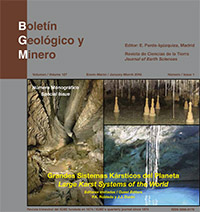The Mammoth Cave system, Kentucky, USA
DOI:
https://doi.org/10.21701/bolgeomin.127.1.009Keywords:
cave, International Biosphere Reserve, Mammoth Cave National Park, World Heritage Site, KentuckyAbstract
Mammoth Cave is the main attraction of Mammoth Cave National Park. For several decades it has been the longest known cave in the world and currently contains 652 km in 2016 of surveyed passages. It is located in the heart of an extensive karst plateau, in which the stratal dip averages only one degree. The cave is part of a drainage basin of more than 200 km². The cave has been known to local inhabitants for several millennia and contains a rich trove of archaeological and historical artifacts. It contains many speleo biota including several rare and endangered species and has been designated a World Heritage Site and an International Biosphere Reserve (UNESCO). Its many passage levels and sediments contain a record of the fluvial history of most of southeastern North America.
Downloads
References
Borden, J.D., and Brucker, R.W., 2000, Beyond Mammoth Cave. Southern Illinois University Press, Carbondale and Edwardsville, Illinois, 353 p.
Brucker, R.W., 2009, Grand, gloomy, and peculiar: Stephen Bishop at Mammoth Cave. Cave Books, Dayton, Ohio, 270 p.
Brucker, R.W., and Watson, R.A., 1976, The longest cave. Alfred Knopf, New York, 316 p.
Granger, D.E., Fabel, D., and Palmer, A.N., 2001, Pliocene-Pleistocene incision of the Green River, Kentucky, determined from radioactive decay of 26 Al and 10 Be in Mammoth Cave sediments. Geological Society of America Bulletin, 113 (7), 825-836. https://doi.org/10.1130/0016-7606(2001)113<0825:PPIOTG>2.0.CO;2
Palmer, A.N., 1981, A Geological Guide to Mammoth Cave National Park. Zephyrus Press, Teaneck, N.J., 210 p.
Palmer, A.N., 1989a, Stratigraphic and structural control of cave development and groundwater flow in the Mammoth Cave region. In White, W.B., and White, E.L. (eds.), Karst Hydrology - Concepts from the Mammoth Cave Area. Van Nostrand Reinhold, New York, p. 293-316. https://doi.org/10.1007/978-1-4615-7317-3_11
Palmer, A.N., 1989b, Geomorphic history of the Mammoth Cave System. In White, W.B., and White, E.L. (eds.), Karst Hydrology - Concepts from the Mammoth Cave Area. Van Nostrand Reinhold, New York, p. 317-337. https://doi.org/10.1007/978-1-4615-7317-3_12
Palmer, A.N., 2007, Cave geology. Cave Books, Dayton, Ohio, 454 p.
Pohl, E.R., 1970, Upper Mississippian deposits of south-central Kentucky. Kentucky Academy of Science Transactions, 31, 1-15.
Quinlan, J.F., and Ray, J.A., 1981, Groundwater basins in the Mammoth Cave region, Mammoth Cave National Park, Kentucky. Friends of Karst Occasional Publication 2, map. Reprinted in White, W.B., and White, E.L., (eds.), 1989, Karst Hydrology - Concepts from the Mammoth Cave Area, Van Nostrand Reinhold, New York, map in pocket.
Schmidt, V.A. 1982, Magnetostratigraphy of Sediments in Mammoth Cave, Kentucky. Science, 217, 827-829. https://doi.org/10.1126/science.217.4562.827
Watson, P.J. (ed.), 1974, The archeology of the Mammoth Cave area. Academic Press, New York, 255 p.
Downloads
Published
How to Cite
Issue
Section
License
Copyright (c) 2024 Consejo Superior de Investigaciones Científicas (CSIC)

This work is licensed under a Creative Commons Attribution 4.0 International License.
© CSIC. Manuscripts published in both the print and online versions of this journal are the property of the Consejo Superior de Investigaciones Científicas, and quoting this source is a requirement for any partial or full reproduction.
All contents of this electronic edition, except where otherwise noted, are distributed under a Creative Commons Attribution 4.0 International (CC BY 4.0) licence. You may read the basic information and the legal text of the licence. The indication of the CC BY 4.0 licence must be expressly stated in this way when necessary.
Self-archiving in repositories, personal webpages or similar, of any version other than the final version of the work produced by the publisher, is not allowed.















